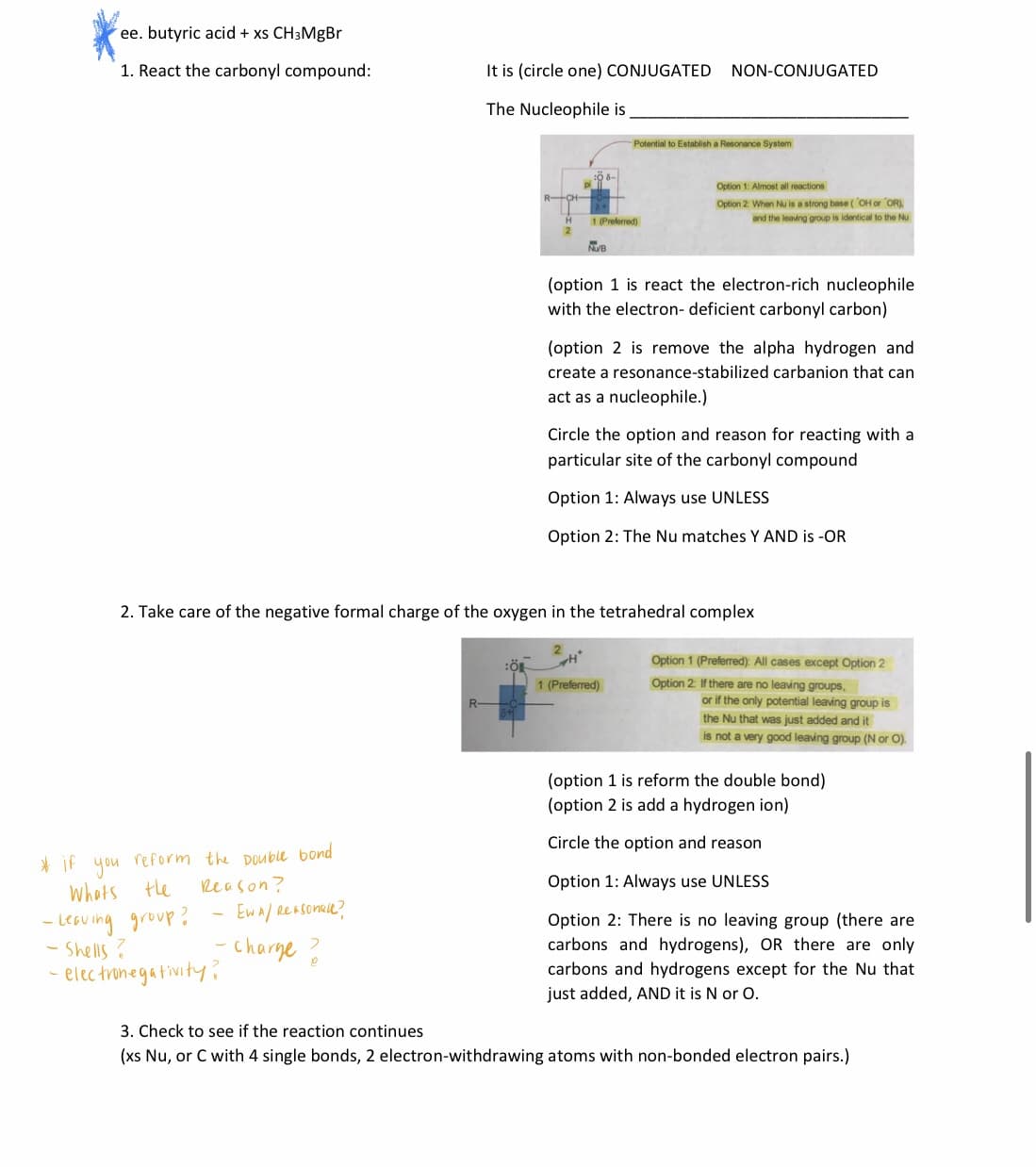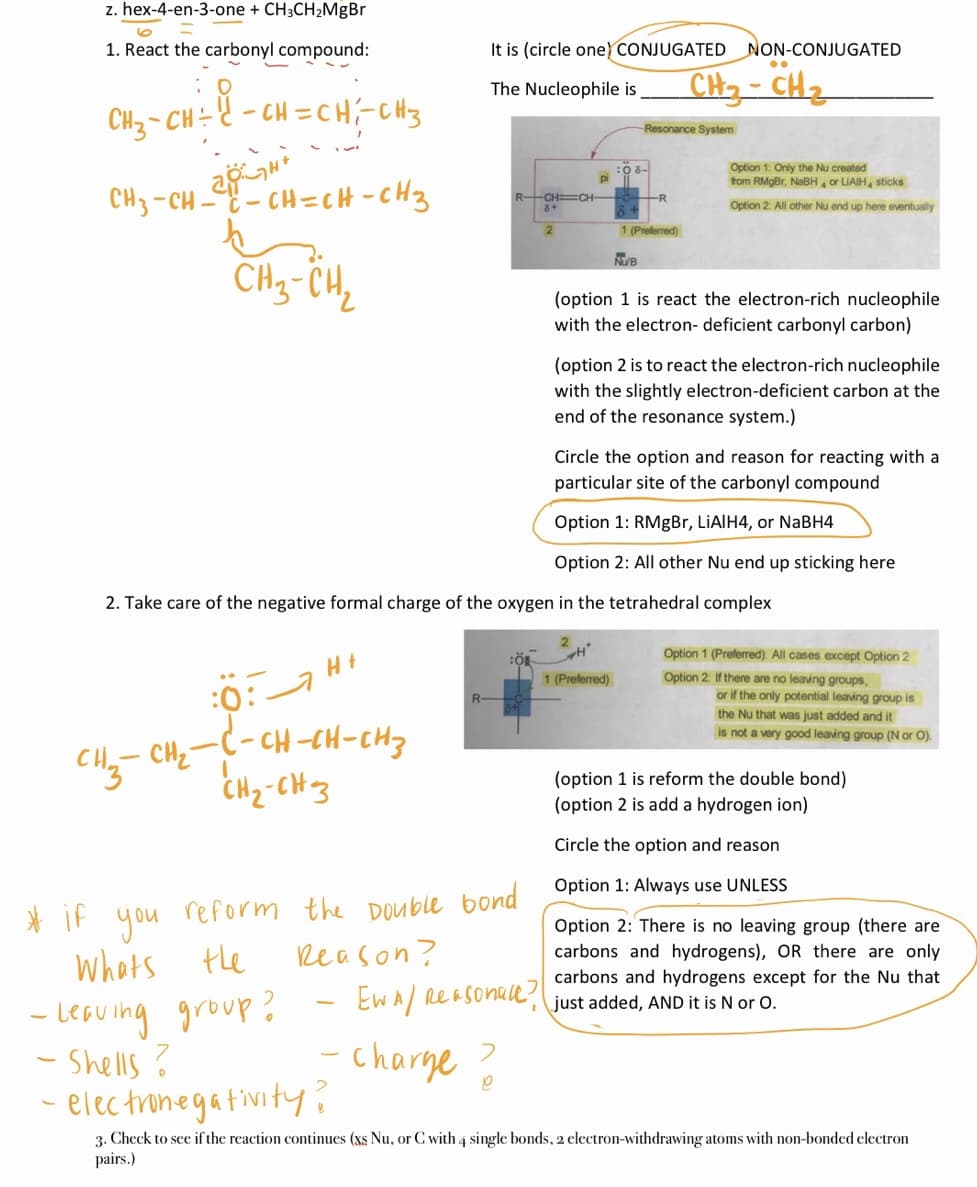ee. butyric acid + xs CH3MgBr 1. React the carbonyl compound: It is (circle one) CONJUGATED NON-CONJUGATED The Nucleophile is Potential to Establish a Resonance System Option 1: Almost all reactions Option 2 When Nu is a strong base (OH or OR), 1 (Preferred) and the leaving group is identical to the Nu (option 1 is react the electron-rich nucleophile with the electron- deficient carbonyl carbon) (option 2 is remove the alpha hydrogen and create a resonance-stabilized carbanion that can act as a nucleophile.) with a Circle the option and reason for react particular site of the carbonyl compound Option 1: Always use UNLESS Option 2: The Nu matches Y AND is -OR 2. Take care of the negative formal charge of the oxygen in the tetrahedral complex Option 1 (Preferred): All cases except Option 2 1 (Preferred) Option 2: If there are no leaving groups, or if the only potential leaving group is the Nu that was just added and it is not a very good leaving group (N or O). (option 1 is reform the double bond) (option 2 is add a hydrogen ion) Circle the option and reason * if you reform the Double bond whots the Reason? Option 1: Always use UNLESS - LeGuing group? Shells ? EwA/ ReASonae? Option 2: There is no leaving group (there are carbons and hydrogens), OR there are only -charge? - elec tronegativity? carbons and hydrogens except for the Nu that just added, AND it is N or O.
ee. butyric acid + xs CH3MgBr 1. React the carbonyl compound: It is (circle one) CONJUGATED NON-CONJUGATED The Nucleophile is Potential to Establish a Resonance System Option 1: Almost all reactions Option 2 When Nu is a strong base (OH or OR), 1 (Preferred) and the leaving group is identical to the Nu (option 1 is react the electron-rich nucleophile with the electron- deficient carbonyl carbon) (option 2 is remove the alpha hydrogen and create a resonance-stabilized carbanion that can act as a nucleophile.) with a Circle the option and reason for react particular site of the carbonyl compound Option 1: Always use UNLESS Option 2: The Nu matches Y AND is -OR 2. Take care of the negative formal charge of the oxygen in the tetrahedral complex Option 1 (Preferred): All cases except Option 2 1 (Preferred) Option 2: If there are no leaving groups, or if the only potential leaving group is the Nu that was just added and it is not a very good leaving group (N or O). (option 1 is reform the double bond) (option 2 is add a hydrogen ion) Circle the option and reason * if you reform the Double bond whots the Reason? Option 1: Always use UNLESS - LeGuing group? Shells ? EwA/ ReASonae? Option 2: There is no leaving group (there are carbons and hydrogens), OR there are only -charge? - elec tronegativity? carbons and hydrogens except for the Nu that just added, AND it is N or O.
Organic Chemistry: A Guided Inquiry
2nd Edition
ISBN:9780618974122
Author:Andrei Straumanis
Publisher:Andrei Straumanis
Chapter8: Addition Via Carbocation
Section: Chapter Questions
Problem 31CTQ
Related questions
Question
100%
The second page is an example how it suppose to be done.
(Hex-4-en-3-one+CH3CH2MgBR). It's complete. Please follow directions.

Transcribed Image Text:ee. butyric acid + xs CH3MgBr
1. React the carbonyl compound:
It is (circle one) CONJUGATED
NON-CONJUGATED
The Nucleophile is
Potential to Establish a Resonance System
Option 1: Almost all reactions
Option 2 When Nu is a strong base (OH or OR).
1 (Preferred)
and the leaving group is identical to the Nu
(option 1 is react the electron-rich nucleophile
with the electron- deficient carbonyl carbon)
(option 2 is remove the alpha hydrogen and
create a resonance-stabilized carbanion that can
act as a nucleophile.)
with a
Circle the option and reason for react
particular site of the carbonyl compound
Option 1: Always use UNLESS
Option 2: The Nu matches Y AND is -OR
2. Take care of the negative formal charge of the oxygen in the tetrahedral complex
Option 1 (Preferred): All cases except Option 2
1 (Preferred)
Option 2: If there are no leaving groups,
or if the only potential leaving group is
the Nu that was just added and it
is not a very good leaving group (N or O).
(option 1 is reform the double bond)
(option 2 is add a hydrogen ion)
Circle the option and reason
* if you reform the Double bond
whots
the
Reason?
Option 1: Always use UNLESS
EwA/ REASonae?
- LeGuing group?
Shells ?
Option 2: There is no leaving group (there are
carbons and hydrogens), OR there are only
-charge ?
- elec trunegativity?
carbons and hydrogens except for the Nu that
just added, AND it is N or O.
3. Check to see if the reaction continues
(xs Nu, or C with 4 single bonds, 2 electron-withdrawing atoms with non-bonded electron pairs.)

Transcribed Image Text:CH3 -CH 2CH=cH-CHz
z. hex-4-en-3-one + CH3CH2MgBr
1. React the carbonyl compound:
It is (circle one) CONJUGATED NON-CONJUGATED
CH- CH2
The Nucleophile is
CH3- CH
= ě - cH = CH;-CHts
Resonance System
Option 1: Only the Nu created
from RMgBr, NaBH or LIAIH, sticks
R
R-CH CH
8+
Option 2 All other Nu end up here eventually
1 (Preferred)
NUB
CHg-CH,
(option 1 is react the electron-rich nucleophile
with the electron- deficient carbonyl carbon)
(option 2 is to react the electron-rich nucleophile
with the slightly electron-deficient carbon at the
end of the resonance system.)
Circle the option and reason for reacting with a
particular site of the carbonyl compound
Option 1: RMgBr, LIAIH4, or NaBH4
Option 2: All other Nu end up sticking here
2. Take care of the negative formal charge of the oxygen in the tetrahedral complex
:0:a Ht
- CH-CH-CH3
CH2-CH3
Option 1 (Prefered). All cases except Option 2
1 (Preferred)
Option 2: If there are no leaving groups,
or if the only potential leaving group is
the Nu that was just added and it
is not a very good leaving group (N or O).
(option 1 is reform the double bond)
(option 2 is add a hydrogen ion)
Circle the option and reason
Option 1: Always use UNLESS
* if u reform the DOuble bond
you
Option 2: There is no leaving group (there are
whots tle
Reason?
carbons and hydrogens), OR there are only
carbons and hydrogens except for the Nu that
Ew A/ ReaSonae?
- LeGuing group?
- Shells ?
elec trinegativity?
just added, AND it is N or O.
|
charge
3. Check to see if the reaction continues (xs Nu, or C with 4 single bonds, 2 electron-withdrawing atoms with non-bonded electron
pairs.)
Expert Solution
This question has been solved!
Explore an expertly crafted, step-by-step solution for a thorough understanding of key concepts.
This is a popular solution!
Trending now
This is a popular solution!
Step by step
Solved in 2 steps with 1 images

Knowledge Booster
Learn more about
Need a deep-dive on the concept behind this application? Look no further. Learn more about this topic, chemistry and related others by exploring similar questions and additional content below.Recommended textbooks for you

Organic Chemistry: A Guided Inquiry
Chemistry
ISBN:
9780618974122
Author:
Andrei Straumanis
Publisher:
Cengage Learning

Organic Chemistry: A Guided Inquiry
Chemistry
ISBN:
9780618974122
Author:
Andrei Straumanis
Publisher:
Cengage Learning